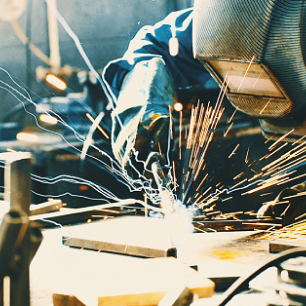Jump to:
Productivity Bundle (Top 5 Welding Productivity Mistakes (and How to Fix Them)
Waste is an inherent problem in many businesses—and welding is no different. In welding, “waste” can mean anything from excessive weld passes to idle equipment to extra footsteps between workstations. Time, materials, and manpower can slip away in ways that aren’t always obvious until the bottom line takes a hit. The good news? Most productivity drains have simple, measurable fixes if you know where to look.
Lean manufacturing principles offer a proven way to identify these inefficiencies, measure their impact, and eliminate them without compromising quality. The AWS Productivity Solutions Bundle brings together three targeted courses that help you apply these methods directly to welding operations, combining cost analysis, workflow optimization, and practical improvement strategies.
Here are the top five mistakes that can sabotage welding productivity—and how using lean manufacturing principles can help to correct them.
1. Ignoring Overlooked Welding Costs
The Issue: Too often, costs are calculated based only on materials and labor rates, leaving out overhead factors like rework, consumables, and equipment downtime. Economics of Welding can provide real-world cost analysis to keep budgets accurate and profits protected.
The Fix: Learn lean management tools to separate value-added activities from non-value-added activities, and account for every dollar—from filler metal to freight—so you can make well-informed decisions. For example, calculating the cost of a single weld pass—including prep, execution, and cleanup—can reveal surprising areas for savings.
2. Overwelding
The Issue: Bigger isn’t better when it comes to weld size. Oversized welds can waste filler metal, increase heat input, and require unnecessary labor. For example, welding ¼” instead of 3/16” can add nearly 78% more work.
The Fix: Learn how to increase your facility’s productivity by applying lean thinking, to match weld sizes to actual requirements. This prevents wasted material and man-hours while still meeting code and quality standards.
3. Workflow Bottlenecks
The Issue: Even small delays in material handling, machine setup, or handoffs can snowball into major slowdowns.
The Fix: Learn how using lean management ideas and tools to map your workflow, spot the choke points, and reorganize tasks to keep production moving smoothly are key to running a successful and profitable welding operation.
4. Inefficient Shop Layout
The Issue: A disorganized workflow forces people and materials to travel farther than necessary, adding wasted motion and delays.
The Fix: Evaluate your shop floor for better material flow, fewer interruptions, and more logical equipment placement. Once you learn How to Increase Your Facility’s Productivity, running pilot programs and making layout changes that stick will become second nature and will have a positive impact on your bottom line.
5. Skipping Continuous Improvement
The Issue: Even efficient operations can stagnate if they don’t adapt. Without a culture of continuous improvement, small problems grow unchecked.
The Fix: Adopt lean practices like Kaizen, kanban, push pull, takt time, and regular review cycles to sustain gains and stay adaptable. These approaches are central to increased facility productivity, and helping teams maintain momentum long-term.
Final Arc
Eliminating waste in welding isn’t about cutting corners—it’s about working smarter. Whether you’re managing a small shop or a large fabrication facility, a targeted approach to productivity can boost output, cut costs, and keep your team competitive.
Download our Welding Productivity Path guide.
Explore the AWS Productivity Solutions Bundle.


